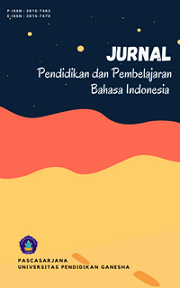AN ANALYSIS OF TEACHER TALK IN ENGLISH CLASSES IN SMK PGRI 4 DENPASAR
Abstract
ABSTRACT
The objective of this study at describing the types of Teacher Talk, the effectiveness/ineffectiveness of Teacher Talk, and the aspect of Teacher Talk in classroom observation. To meet the objective, sampling technique was employed to select three classes together with the three English teachers who taught in those classes. The data were collected through recorded classroom interaction, observer’s field notes and questionnaire, while the data were analyzed qualitatively on the basis of Flander’s Theory of the Teacher Talk (1980).
The Analysis of Teacher Talk Types includes identifying the different types of Teacher Talk, categorizing the various types of Teacher Talk into ten footing patterns and generalizing the relationship among these footing. The findings reveal that the three teachers most frequently used six footings such as Mediator, Evaluator, Learning task assignor, teaching material interpreter, inspector and classroom climate conductor.
The observation used three instruments to analyze the data; Flanders Interaction Analysis Categories (FIAC) to identify the classroom interactions, teaching effectiveness elements based on the Walberg’s theory, and Likert Scale to measure the students’ opinion resulted from questionnaire. The results of the analysis showed that the most dominant characteristic in English classes was the student participation. It reflected that most of the teaching-learning time was devoted to questions and answers by the students. But, without the Teacher Talk the students could not devote their participation. The teacher spent 59.52% of the teaching-learning time, while the students spent 69.05% of the teaching-learning time. It showed that the students were active in the classroom interaction. The interaction in these English classes was in three-way communication; there were interaction between teacher-student, student-teacher, and students-students. The English classroom interaction also met the requirements of teaching effectiveness elements by Walberg (1986). The teaching effectiveness elements used in the classroom were in the form of academic learning time, the use of reinforcement, cues and feedback, co-operative learning, classroom atmosphere, higher order questions, advance organizers, direct instruction, indirect teaching and democratic classroom. Based on the students’ opinion, the teaching learning process in the classroom was good enough however some students felt uncomfortable with the classroom atmosphere and the teacher’s discipline of time.
The research found that there are three major Teacher Talk Aspects, covering physiological aspect, interpersonal aspect, pedagogical aspect, which are stated as strong / effective aspects.
Keyword: teacher talk, types of teacher talk, classroom interaction
ABSTRAK
Penelitian ini bertujuan untuk mendeskripsikan jenis Tuturan Guru, efektivitas / tidak efektifnya Tuturan Guru, dan aspek Tuturan Guru di observasi kelas. Untuk memenuhi tujuan, teknik sampling yang digunakan untuk memilih tiga kelas bersama dengan tiga guru Bahasa Inggris yang mengajar di kelas. Data dikumpulkan melalui interaksi kelas yang direkam, catatan lapangan pengamat dan kuesioner, sedangkan data dianalisis secara kualitatif berdasarkan Teori Flander terhadap Tuturan Guru (1980).
Analisis Jenis Tuturan Guru mencakup identifikasi berbagai jenis Tuturan Guru, jenis Tuturan Guru dikategorikan menjadi sepuluh pola pijakan dan generalisasi saling berhubungan antara pijakan – pijakan tersebut. Temuan menunjukkan bahwa tiga guru yang paling sering digunakan enam pondasi seperti Mediator, Evaluator, Belajar tugas pemberi tugas, mengajar juru material, Inspektur dan konduktor kelas iklim.
Pengamatan menggunakan tiga instrumen untuk menganalisis data; Flanders Kategori Analisis Interaksi (FIAC) untuk mengidentifikasi interaksi kelas, elemen efektivitas mengajar berdasarkan teori Walberg, dan Skala Likert untuk mengukur pendapat siswa dihasilkan dari kuesioner. Hasil analisis menunjukkan bahwa karakteristik yang paling dominan dalam kelas bahasa Inggris adalah partisipasi siswa. Ini mencerminkan bahwa sebagian besar waktu belajar-mengajar yang telah dikhususkan untuk pertanyaan dan jawaban oleh para siswa. Tapi, tanpa Guru Bicara siswa tidak bisa mencurahkan partisipasi mereka. Guru menghabiskan 59,52% dari waktu belajar mengajar, sedangkan siswa menghabiskan 69,05% dari waktu belajar-mengajar. Hal ini menunjukkan bahwa siswa aktif dalam interaksi kelas. Interaksi dalam kelas-kelas bahasa Inggris dalam tiga-arah komunikasi; ada interaksi antara guru-siswa, siswa-guru, dan siswa-siswa. Interaksi kelas bahasa Inggris juga memenuhi persyaratan unsur efektivitas mengajar oleh Walberg (1986). Unsur-unsur efektivitas mengajar digunakan di dalam kelas adalah dalam bentuk waktu belajar akademis, penggunaan penguatan, isyarat dan umpan balik, koperasi belajar, suasana kelas, pertanyaan orde tinggi, penyelenggara muka, instruksi langsung, tidak langsung dan mengajar kelas demokratis. Berdasarkan pendapat para siswa, proses belajar mengajar di kelas cukup baik namun beberapa siswa merasa tidak nyaman dengan suasana kelas dan disiplin guru waktu.
Penelitian ini menemukan bahwa ada tiga Aspek utama Bicara Guru, meliputi aspek fisiologis, aspek interpersonal, aspek pedagogis, yang dinyatakan sebagai aspek yang kuat / efektif.
Kata Kunci: tuturan guru, jenis tuturan guru, interaksi kelas
Full Text:
PDFRefbacks
- There are currently no refbacks.






